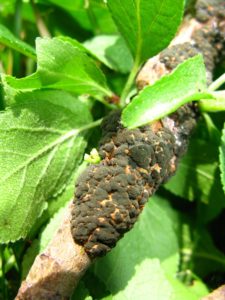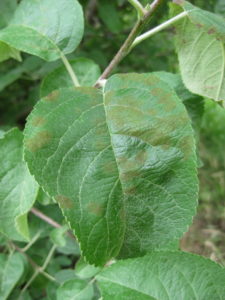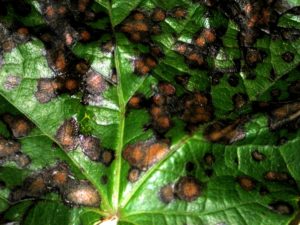Apple Disease Management
Constant rain has resulted in a great scab season. Again. Keep in mind that infection develops really slowly under these (mostly) cool, wet conditions. This means symptoms from primary infection may have just started to be visible and that we are already going into secondary infection even as primary infection continues. With the constant rain, and infection, I want to warn people from thinking ‘Fungicide resistance!’, as opposed to what really happened—heavy rains that washed off any trace of fungicide, plus a long, cool wet infection period that delayed symptom development. Hopefully, everyone was able to get into their orchard and get their applications on to protect against scab, powdery mildew and rust. And of course, bitter rot.
Black Knot
Prune out, remove or dispose of any and all visible black knot galls. Sanitation is a cornerstone of management! Ascospores of the black knot fungus, Apiosporina morbosa, are being released with right now a peak time throughout the state. For those not at shuck split, continue using chlorothalonil (FRAC Code M5). After shuck split, rotate with Indar (fenbuconazole, FRAC Group 3), Topsin-M (thiophanate methyl, FRAC Code 1), captan (FRAC Code M), and Pristine (FRAC 11+7 ). Many of the fungicides labeled to control brown rot will also control black knot.

Fig. 2. Black Knot. Photo by Janna Beckerman.
Grapes Disease Management
With all this wet weather, grapes will require continued protection against Phomopsis and against black rot. Preventing foliar disease by these fungi reduces the likelihood of fruit infections. Mancozeb and captan are both very effective and provide excellent protection early in the season. Protectant fungicides like these must be applied to shoots and leaves before inoculation and infection by spores. During rain, fungicides will wash off. A simple rule of thumb is that for every inch of rain, a 50% loss of fungicide occurs. Keep in mind that Mancozeb protects against early downy mildew infection as well. This approach saves the use of systemic fungicides until later in the season, when issues of canopy growth may prevent you from obtaining ideal coverage, and give you the protection you need in places the sprayer can’t reach.

